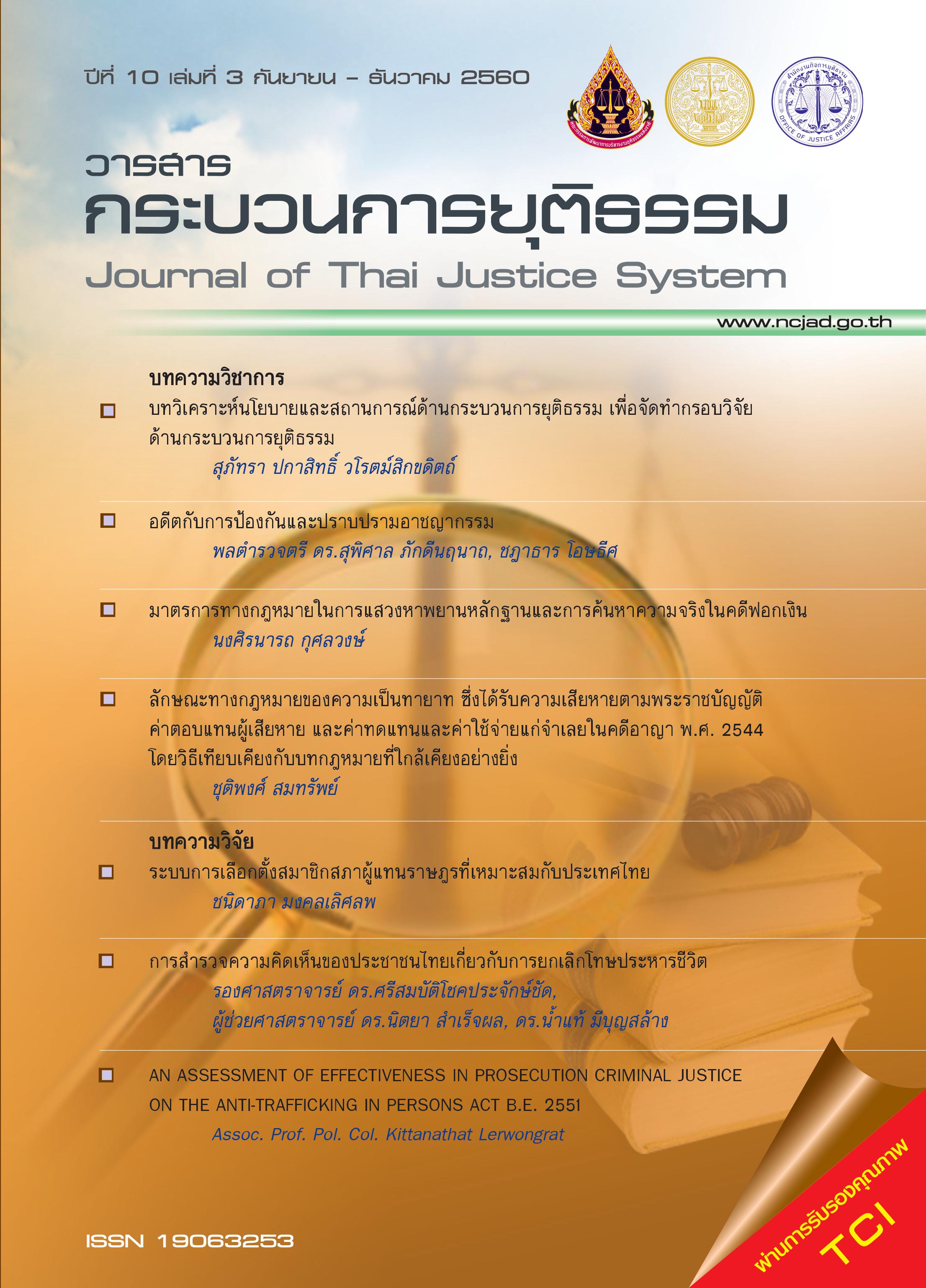การสำรวจความคิดเห็นของประชาชนไทยเกี่ยวกับการยกเลิกโทษประหารชีวิต
Main Article Content
บทคัดย่อ
การวิจัยเรื่อง “การสำรวจความคิดเห็นของประชาชนไทยเกี่ยวกับการยกเลิกโทษประหารชีวิต มีวัตถุประสงค์เพื่อสำรวจความคิดเห็นกลุ่มตัวแทนจากทุกภาคส่วนคลอบคลุมทุกจังหวัดทั่วประเทศในประเด็นการยกเลิกโทษประหารชีวิต วิธีการวิจัยใช้การวิจัยแบบผสมผสานระหว่างการวิจัยเชิงปริมาณและเชิงคุณภาพการวิจัยเชิงปริมาณใช้การสำรวจกับกลุ่มตัวอย่างจำนวนทั้งสิ้น 2,374 คน จากกลุ่มที่เข้ารับการอบรมให้ความรู้และกลุ่มตัวอย่างสำรวจผ่านเว็บไซด์ ส่วนการวิจัยเชิงคุณภาพใช้ การเก็บข้อมูลเอกสาร การสัมภาษณ์เชิงลึกจำนวน 27 คนกับผู้ทรงคุณวุฒิ และผู้ที่เคยเป็นเหยื่อของกระบวนการยุติธรรม และนักโทษประหารชีวิต และการสนทนากลุ่มย่อยจำนวน 50 กลุ่มจากทุกพื้นที่ภาค
ผลการวิจัยพบว่าจากการสำรวจความคิดเห็นว่า “ประเทศไทยควรจะมีโทษประหารชีวิต หรือว่าควรจะยกเลิกโทษประหารชีวิต” พบว่ากลุ่มตัวอย่างที่ผ่านการอบรมให้ความรู้ มีความเห็นในการสนับสนุนโทษประหารชีวิตในอัตราร้อยละที่ลดลงโดยก่อนการให้ความรู้ มีความเห็นคิดเห็นที่สนับสนุนโทษประหารชีวิต ร้อยละ 72.6 ภายหลังการให้ความรู้ มีความเห็นในการสนับสนุนโทษประหารชีวิตในอัตราร้อยละที่ลดลง เพียงร้อยละ 68.7 ในขณะที่กลุ่มตัวอย่างที่สำรวจข้อมูลผ่านเว็บไซด์ ส่วนใหญ่มีความเห็นสนับสนุนโทษประหารชีวิตถึงร้อยละ 88 สำหรับการสัมภาษณ์เชิงลึกส่วนใหญ่เห็นด้วยที่ให้คงโทษประหารชีวิต เว้นแต่กลุ่มนักโทษประหารชีวิตทั้ง 9 คนเห็นควรยกเลิกโทษประหารชีวิต การสนทนากลุ่มย่อยทั้ง 50 กลุ่มพบว่า 44 กลุ่มเห็นด้วยให้มีโทษประหารชีวิต มีเพียง 6 กลุ่มที่คัดค้านโทษประหารชีวิต นอกจากนี้ผลการวิจัยพบเหตุผลที่สนับสนุนการมีโทษประหารชีวิต และเหตุผลที่คัดค้านโทษประหารชีวิต รวมทั้งสำรวจความคิดเห็นเกี่ยวกับคดีที่มีฐานความผิดต่างๆที่ถูกกำหนดโทษประหารชีวิตตามกฎหมาย ว่าควรมีการยกเลิกโทษประหารชีวิตในฐานความผิดประเภทใดบ้าง
Article Details
ต้นฉบับที่ได้รับการตีพิมพ์ในวารสาร เป็นลิขสิทธิ์ของวารสารกระบวนการยุติธรรม แต่ความคิดเห็นที่ปรากฏในเนื้อหาของบทความในวารสารกระบวนการยุติธรรม ถือเป็นความรับผิดชอบของผู้เขียนแต่เพียงผู้เดียว
เอกสารอ้างอิง
คณะอนุกรรมการปฏิบัติการยุทธศาสตร์ด้านสิทธิในกระบวนการยุติธรรม สำนักงานคณะกรรมการสิทธิ มนุษยชนแห่งชาติ. (2557). โทษประหารชีวิตในประเทศไทย. (บทสรุปผู้บริหาร).
นัทธี จิตสว่าง. (2557). การยกเลิกโทษประหารชีวิตในประเทศไทย: กระแสสากลกับกระแสภายในประเทศ. คัดลอกเมื่อ 20 กรกฎาคม 2557 จาก https://www.gotoknow.org/posts/556740
พระราชบัญญัติแก้ไขเพิ่มเติมประมวลกฎหมายอาญา (ฉบับที่ 16) พ.ศ. 2546. (2546). ราชกิจจานุเบกษา. เล่มที่ 120 ตอนที่ 58 ก ลงวันที่ 20 มิถุนายน 2546.
พระราชบัญญัติแก้ไขเพิ่มเติมประมวลกฎหมายวิธีพิจารณาความอาญา (ฉบับที่ 25) พ.ศ. 2550. (2550).
ราชกิจจานุเบกษา. เล่มที่ 124 ตอนที่ 53 ก ลงวันที่ 12 กันยายน 2550.
วิชัย เดชชุติพงศ์. (2555). ข้อดีข้อเสียของโทษประหารชีวิตกับสังคมไทย. คัดลอกเมื่อ 1 มกราคม 2557 จาก http://elib.coj.go.th/Ebook/data/judge_report/jrp2555_10_25.pdf
ศรีสมบติ โชคประจักษ์ชัด น้ำแท้ มีบุญสร้าง และนิตยา สำเร็จผล. (2557). รายงานฉบับสมบูรณ์โครงการ ศึกษา ความเป็นไปได้ของการยกเลิกโทษประหารชีวิต ตามแผนสิทธิมนุษยชนแห่งชาติ ฉบับที่ 2
กรมคุ้มครองสิทธิและเสรีภาพ กระทรวงยุติธรรม. พิมพ์ที่ร้านพุ่มทอง: กรุงเทพมหานคร
Albanese, J. (1999). Criminal Justice. Boston: Allyn and Bacon.
Amnesty International, (AI). (2013). Not Making Us Safer: Crime Public Safety and the Death Penalty. UK. Amnesty International Publications.
Amnesty International. (2014). Death sentences and executions in 2013. international secretariat, UK.
Council of Europe. (1998). the Protocol No.6 the Convention for the Protection of Human Rights and Fundamental Freedoms concerning the Abolition of the Death Penalty as Amended by Protocol No. 11. Retrieved 15 May 2015 from http://www.echr.coe.int/Documents/Library_Collection_P6_ETS114E_ENG.pdf
Criminal Justice Legal Foundation. (2014). Tally of Death Penalty Deterrence Studies
Published Peer-Reviewed Journals from 1996 to 2010. Retrieved 12 June 2014 from http://www.cjlf.org/deathpenalty/dpdeterrence.htm
Fagin, J. A. (2010). Upper Saddle River. NJ: Prentice Hall.
Fiacat. (2007). World Day against the Death Penalty -10 October. Retrieved 15 May 2014 from
http://www.fiacat.org/-world-day-against-the-death-penalty-2007-the-world-decides-
Hood, R. (2013). The Death Penalty in Malaysia: Public opinion on the mandatory death penalty for drug trafficking, murder and firearms offences. London: The Death Penalty Project and Bar Council Malaysia.
International Commission Against Death the Penalty, ICDP (2013a). Mandate. Retrieved 15 May 2014 from http://www.icomdp.org/
International Commission Against Death Penalty (ICDP). (2013b). How state abolishes the death penalty. Retrieved 20 January, 2014 from http://www.icomdp.org/cms/wp content/uploads/2013/04/Report-How-States-abolition-the-death-penalty.pdf
Johnson, D.T.& Franklin E. Zimring, F.E.(2009). The Next Frontier: National Development, Political Change, and the Death Penalty in Asia, United States: Oxford University Press.
Organization of American States, OAS. (1969). American Convention on Human Rights. Retrieved June 6 2014 from
http://www.cidh.oas.org/basicos/english/basic3.american%20convention.htm
Organization for Security and Co-operation in Europe, OSCE. (2015). Our history. Retrieved 15 May 2015 from http://www.osce.org/
Office of High Commissioner Human Rights, OHCHR. (1994). General Comment No. 24: Issues relating to reservations made upon ratification or accession to the Covenant or the Optional Protocols thereto, or in relation to declarations under article 41 of the Covenant: 04/11/94. CCPR/C/21/Rev.1/Add.6, General Comment No. 24. (General Comments). Retrieved 15 May 2015 from http://www.equalrightstrust.org/ertdocumentbank//general%20comment%2024.pdf
Silverman, I. J. & Vega, M. (1996). Corrections: A comprehensive view. Minneapolis, MN: West.
The Death Penalty Project. (2011). The Death Penalty Project: Working to promote and protect the human rights of those facing the death penalty, Five year report: 2006 to 2011. UK: The Death Penalty Project.
United Nations Treaty Collection. (1945). Charter of the United Nations and Statute of the International Court of Justice. Retrieved 15 May, 2015 from https://treaties.un.org/doc/source/docs/charter-all-lang.pdf
United Nations. (1976). International Covenant on Civil and Political Rights. Retrieved 15 May 2025 from https://treaties.un.org/doc/Publication/UNTS/Volume%20999/volume-999-I- 14668-English.pdf
United Nations. (2015) Universal Declaration of Human Rights 1948. Retrieved 15 May 2015
fromhttp://www.un.org/en/udhrbook/pdf/udhr_booklet_en_web.pdf


